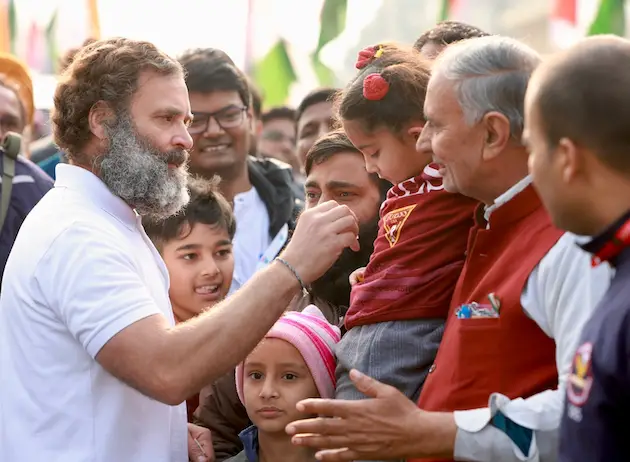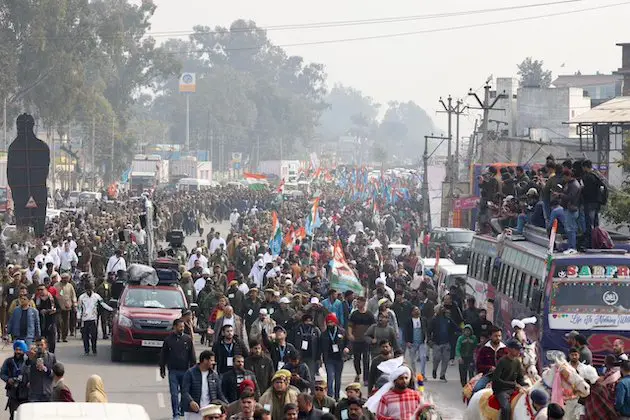When a crowd of supporters of the Indian National Congress Party (INCP), the country’s main opposition party, arrive in Srinagar on January 30 to hoist the country’s flag, they will culminate a 3570-kilometre, 150-day march.
The NIC organised the Bharat Jodo Yatra (BJY), the long march on foot, to counter what it calls the divisive and polarising politics of the ruling Bhartiya Janata Party (BJP) and Prime Minister Narendra Modi.
The stated aim is to revive the idea of India as a united country in all its diversity.
The BJY is led by 52-year-old NIC president Rahul Gandhi, who has been meeting countless citizens along the way and has made numerous statements, in contrast to 72-year-old Modi, who has not held a single press conference in his nine years in power.
Gandhi is the last representative of the Nehru-Ghandi dynasty, which has ruled India for much of its 75 years as an independent country, making him the son, grandson and great-grandson of Indian rulers.
Founder and editor of The Citizen, Seema Mustafa, told IPS that Gandhi succeeded in leading won by leading the BJY.
“He has become a leader of substance, courage, honesty and compassion. What the Congress party has gained will only be known when its leaders can realise it. After that will come other gains and losses, but for now, the BJY has cut through the prevailing atmosphere of fear and hatred,” Mustafa said.
The BJY will culminate in the northern Himalayan region of Kashmir on 30 January, but the question is whether it will have the same reception as in the rest of the country. For nearly half a century, Kashmiris have complained about the negative attitude of Delhi’s elites towards them.
As Dulat, master of espionage and former head of India’s Intelligence Agency and its Research and Analysis Wing (RAW), received a personal invitation to join the BJY. He walked for an hour with Ghandi, but Dulat did not reveal if they discussed the troubled province of Kashmir.
Dulat’s latest book, “A Life in the Shadows”, is about Kashmir, a place he loves, ever since he was first posted there in the late 1980s. He is noted as a problem solver and benefactor to many diverse people in that troubled region, including separatists and Pakistanis, earning him the nickname “Mr Kashmir”.
Dulat told the media that participating in the BJY was a wonderful experience.
Gandhi wrote in his invitation to Dulat: “We listen to anyone who wants to be heard. We do not judge or give opinions. We walk to unite all Indians, irrespective of sex, caste or religion, because we know that they are equal citizens. We walk to fight hatred and fear”.
Dulat, for his part, commented: “I think what this young man is doing is certainly something exceptional, unbelievable. He doesn’t think anyone will ever do it again, and he doesn’t think anyone will ever walk so many kilometres again.

Defence Minister Rajnath Singh accused Gandhi of tarnishing India’s image by creating the impression that only hatred reigns in the country.
The BJY began on 7 September at the southern tip of the Indian peninsula in Kanyakumari and has marched relentlessly through 12 provinces.
During the march, Gandhi has been making personal contact with dozens of citizens from different walks of life. After walking about 25 kilometres a day in two shifts, the NIC activists slept in makeshift shelters.
Speaking to IPS, Zoya Hasan, a professor at Jawaharlal Nehru University, which has its campus in the capital, agreed that the march had been a success.
“If crowds are any indicator, the BJY got an enthusiastic response in all the states it passed through. This shows that there is still space in the country for inclusive politics,” he said.
Many feel that the long march has changed the mood of the country.
It has restored hope to a citizenry that increasingly feared for their future and their security if they did not belong to the sectors included in the ultra-nationalism that Modi is pushing, mixed with populist politics and a so-called “strong government” against minorities, which has marked his power in the world’s most populous democracy.
Largely ignored by the mainstream (mostly pro-government) media, the BJY has instead been streamed live on social media.
Seeing supporters travel thousands of kilometres and meet hundreds of thousands of people of all religious faiths, all ethnic groups and all social classes, mingling, hugging, shaking hands and making friends has reinforced positive ideas of the goodness of togetherness among citizens.
Since the BJP came to power in 2014, the mood in the nation has been sombre. Besides facing the never-ending scourge of poverty, the country has had to deal with repeated incidents of public violence and discrimination and repression against minorities.
Critical analysts say Modi and his party at best ignore and at worst encourage violence by citizens and divide Indian society by religious affiliation.
Bengali Indian Nobel laureate Amartya Sen told the French daily Le Monde that the current Indian government is one of the most terrible in the world because it is “communitarian (championing the communal over the individual)” in the strictest sense of the term. It harms India by attacking Muslims and propagating the idea that Hindus form the nation.
Many consider the long march led by Ghandi a success, as a political protest against the divisive politics of the right-wing, nationalist ruling party, and also a wake-up call for national change in this country of more than 1.4 billion people, which is about to overtake China as the world’s most populous.
“I joined the march and walked with Rahul Gandhi not because I am a fan of the Congress Party, but because I thought this young man has stood for the right values at the right time, and I support similar values,” said filmmaker Saeed Mirza at the launch of his book I Know The Psychology of Rats in Penaji, capital of the state of Goa.
I believe that every Indian who wants love and inclusion should participate in the long march, irrespective of political identity,” said Tushar Gandhi, who joined the march in November.
Tushar is the great-grandson of Mahatma Gandhi, and Rahul Gandhi is the great-grandson of Jawaharlal Nehru, India’s former prime minister, and grandson of his daughter and successor in the dynasty, Prime Minister Indira Ghandi.
“Although this is an event organised primarily by the Congress, it is not exclusively Congress. So, all Indians have been welcomed with open arms, and that is as it should be. If political pettiness comes in the way, it will be counterproductive,” Tushar Gandhi added.
The Congress party says the BJY’s aim is to fight the politics of fear, bigotry and prejudice, and the economics of livelihood destruction, rising unemployment and growing inequalities.
“What the yatra (long march) has achieved far exceeds the expectations of the sceptics. They have been proved wrong, and I include myself in this category. A suffocated nation was waiting for such an event,” wrote journalist Saeed Naqvi.
Hasan adds that the BJY has renewed the Congress’ credentials as a party of national unity and social cohesion, upholding the values of secularism, welfare of the masses and their constitutional rights.
This, in the view of many analysts, creates a major dent in the hyper-nationalist narrative of the ruling party’s politics.
According to Hasan, the impact of the BJY has been that the ruling party has ceased to set the agenda, but has been forced to react to the Congress party’s initiative.
Only time will tell if the grand march will bring electoral benefits to the Congress Party in the 2024 general elections, Hasan says it is “a necessary first step” to “build a politics of change” in India, as opposed to the sectarian ultra-nationalism of Modi and his party.






